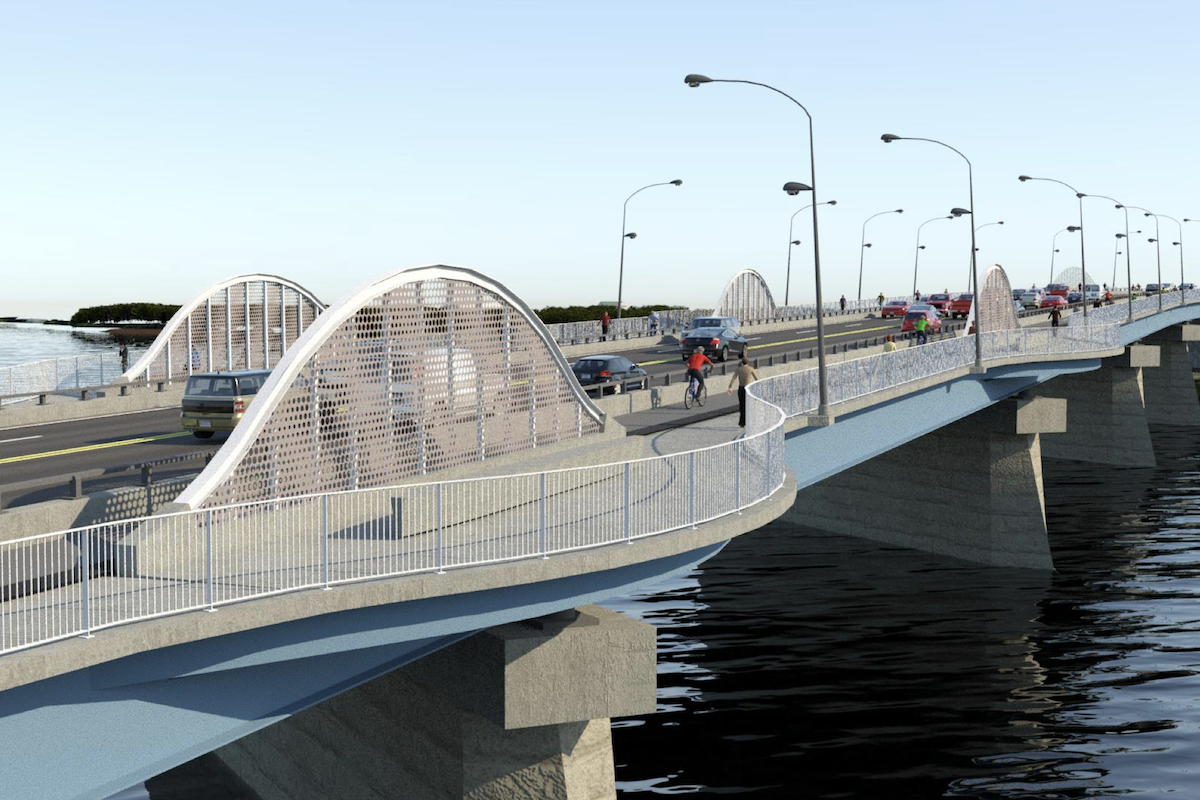Interstate 35 (I-35) and Interstate 240 (I-240) intersect in Oklahoma City, Oklahoma, where Allen Contracting Inc./Shell Construction Co. Inc. and the Oklahoma Department of Transportation (ODOT) are in the middle of a multi-phase project to modernize the I-35/I-240 interchange.
The team is currently working on phase 1B, which began in the summer of 2023. Phase 1 (which was followed by 1A) began in 2016 and was completed in 2018. Upon completing Phase 1B, the team will continue with phases two through four, which will run concurrently. The overall project is expected to be completed in 2031.
“Phases 1, 1A, and 1B are all preparatory. They are setting the stage, so we’ll be ready to build bridges,” said Jonathan Brooks, an ODOT Resident Engineer overseeing the project and serving as the Engineer of Record for construction issues. The phases were not concurrent due to budgeting constraints.
The final three phases involve building bridges and enabling ramp-to-ramp movements.
The current interchange is about 50 years old, and it is outdated. There are multiple conflict points resulting in a high accident rate. In 2021, the most recent year that data is available, there were over 240 accidents around the interchange that resulted in 54 injuries and one fatality.

| Your local Hyundai dealer |
|---|
| Equipment East |
I-240, which serves the south side of the metro Oklahoma City area and has two through lanes in each direction, had an annual average daily traffic (AADT) of 80,000 in 2021. I-35, which has three through lanes in each direction, has an even higher AADT at 131,000.
Oklahoma City became America's 20th largest city in 2021, and it continues to grow. According to 2022 U.S. Census Bureau population estimates, it was the sixth-fastest-growing top 20 city from 2020 to 2022. The growing metro area is impacting the local infrastructure. The new interchange has a larger footprint and smoother horizontal curves to enable faster movement. It will also improve capacity and allow for better traffic flow.
The project area is near a significant amount of development including a hospital, the Will Rogers World Airport, Tinker Air Base, and the University of Oklahoma.
The team is focusing on multiple significant elements during phase 1B. They include:

| Your local Esco Corporation dealer |
|---|
| Genalco |
- Building two complete ramps (northbound I-35 to eastbound I-240 and eastbound I-240 to eastern off-ramp) and two partial ramps that will connect to the future bridges.
- Adding a third through lane in each direction through some parts of I-240.
- Rebuilding a section of I-240. The work on this project’s portion of I-240 consists of about 4,000 feet of complete reconstruction starting at stabilized subgrade and featuring an asphalt driving surface.
- Rebuilding three service roads. The northwest, southeast, and northeast quadrant’s service roads are being rebuilt to match the geometry of the future stack interchange. The former service roads would conflict with the new ramps and bridges.
- Building a protected turnaround lane at 59th Street and I-35. Drivers will use this lane to make a U-turn to easily turn back south from the northbound I-35 off-ramp to 59th Street, as the lane does not have any traffic lights and a clear merge.
- Relocating five water mains and six sanitary sewers to avoid conflict with future work.
- Replacing two railroad bridges that carry BNSF trains. BNSF is one of the largest freight railroads in the U.S.
The team has dealt with a few challenges during construction, one of them being traffic maintenance. In addition to the area attractions noted above, the interchange is a gateway to the large and growing suburbs. The traffic in the area is very directional — northward during the morning rush and southward in the evening.
“While we’re able to periodically close lanes overnight, we can’t do so during the day,” Brooks said. “There’s no official detour, and we’re trying to maintain as many lanes as possible.” However, lanes have been narrowed to allow work during the day. This has led to some daytime slowdowns.
ODOT’s communications team has distributed information related to the project via the standard channels — Facebook, X, email, etc. — to get the word out. An automated advanced warning system on the interstate also shares information.

| Your local Volvo Construction Equipment dealer |
|---|
| Tyler Equipment |
Coordination with other entities and agencies, such as Oklahoma City and the BNSF railroad, is also challenging. “The railroad has some detailed safety regulations which are challenging to work around since we don’t usually work around them,” Brooks said. “It also adds another layer of approval we need to gather and requires us to navigate an extra agency.”
In addition, the team is coping with a unique geotechnical issue on this project — perched water. Perched water is groundwater occurring in a saturated zone separated from the main body of groundwater by unsaturated rock. In this case, water was trapped under a rock layer. The team discovered it while excavating.
“When we did our cut, water was released,” Brooks said. This issue was not detected during design, which comes as no surprise since it was at a higher elevation than one would expect based on the geology.
Brooks compares it to a sponge. There is water in the middle that the team pumped out. Water from the edges then rushes back to the middle. Water does not simply rush out. Instead, it slowly accumulates. The site could be dry in the evening when the crew leaves, but when they return the next morning, a large puddle has formed.

| Your local Trimble Construction Division dealer |
|---|
| SITECH Northeast |
The team uses underdrains (like large French drains) to collect the water and keep it off the project. They are also using an open-graded rock aggregate as a base to carry water to the underdrains.
Selected based on low bid, Allen Contracting Inc./Shell Construction Co. Inc. is the general contractor for this phase. They served in the same capacity in Phase 1.
Brooks said he has been impressed with the general contractor. “They’re a large, competent, and well-regarded company,” he said. “They’ve done other large interchange projects in the metro Oklahoma City area and have a good relationship with us.” He added that the firm is very organized and interfaces well with ODOT.
Allen/Shell also is going to apply an innovative approach to remove and install the bridges. The general contractor has used large heavy movers that can support the weight of the bridge. The movers are strong enough to take the bridge and drive it away.

| Your local Case Construction Equipment Inc dealer |
|---|
| Beauregard Equipment |
| Monroe Tractor |
“They can easily remove bridges and/or build them off site and transfer the bridge to the work site. ... A bridge could be up on a Friday and be gone by the Monday morning commute,” Brooks said.
The contract for Phase 1B was $72.2 million (significantly more than 1 and 1A). The project is 100% federally financed via the National Highway Performance Program (NHPP).
According to the U.S. Department of TransportationFederal Highway Administration’s website, “The NHPP provides support for the condition and performance of the National Highway System (NHS), for the construction of new facilities on the NHS, and to ensure that investments of federal-aid funds in highway construction are directed to support progress toward the achievement of performance targets established in a state's asset management plan for the NHS.”
Brooks said the project is currently slightly over budget and behind schedule. The same reasons are the cause: perched water, some additional design due to utility, and the railroad bridges.

| Your local Wirtgen America dealer |
|---|
| United Construction & Forestry |
| WI Clark |
When the final phase is completed and the new interchange is unveiled, drivers will benefit from a modernized interchange with a higher capacity, the ability to travel at greater speeds, and additional safety compared to the old interchange.
“The current interchange is infamous for being difficult to navigate,” Brooks said. “The new interchange will result in fewer collisions and be safer, which is our top priority at ODOT. The new interchange is like the others in the metro Oklahoma City area.”
- Owner: Oklahoma Department of Transportation
- General Contractor: Allen Contracting Inc./Shell Construction Co. Inc., Oklahoma City, Oklahoma
- Project Designer: Poe and Associates Inc., Oklahoma City, Oklahoma; Project Engineer, Tommy Evans, PE
- Other Key Contractors: AH Beck Foundation Company, Converse, Texas; Matthews Trenching Company, Oklahoma City, Oklahoma







































































